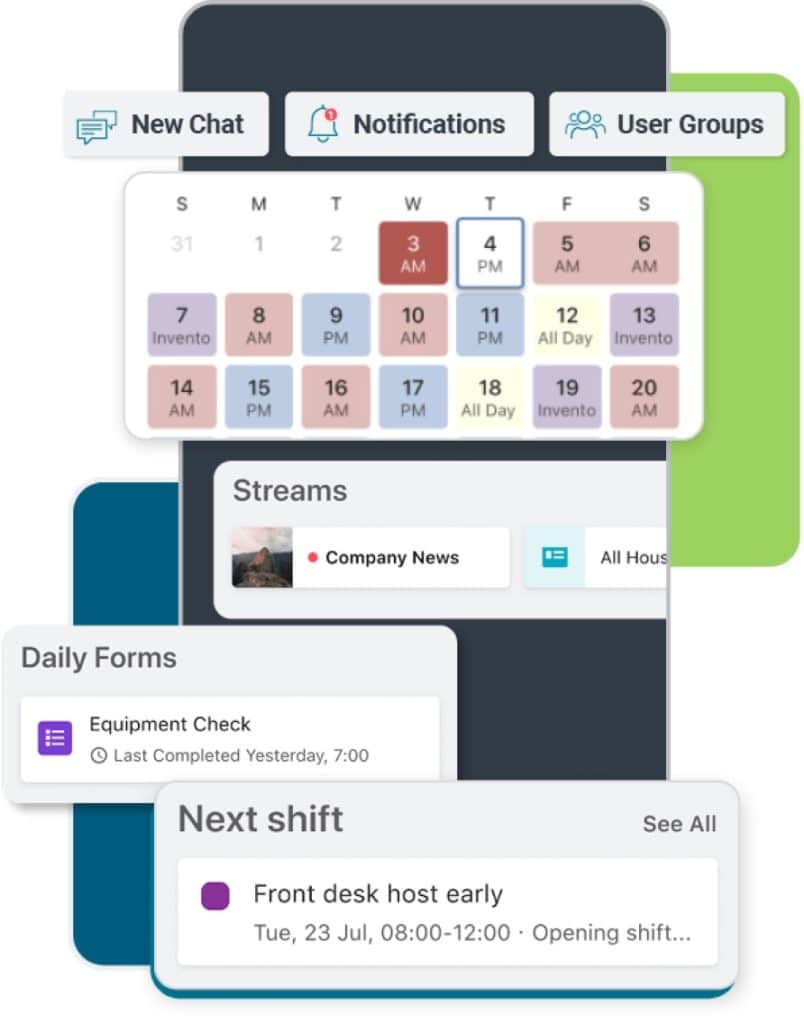Digital Workplace Trends: Here’s What’s Hot on the Frontline

Frontline workers have always been important. They’re the ones who build our homes, transport our goods, sell our products, and assist our customers. Frontline workers in the service industry make people feel comfortable, while workers in manufacturing make the goods that drive the economy. They’ve always represented the majority of the workforce—and as the war for frontline talent rages on, they’re more important than ever.
More than 31 million Americans work on the frontline, and 80% of the global workforce is on the frontline. In fact, 90% of industries rely on frontline workers in one form or the other.
Despite that, frontline workforce technology has always lagged behind.
That’s changing. Frontline workers are beginning to demand — and get — the technology they need to do their best work.
Frontline work is becoming increasingly digitized, and frontline-majority businesses need to keep up. That means evaluating digital workplace trends and understanding what’s happening at the leading edge of the frontline.
What Is a Digital Workplace on the Frontline?
We’re all familiar with the digital workplace tech for office workers. Employees message each other, work on shared documents, and create and distribute information from laptops and mobile devices. The digital workplace empowers employees to be away from the office and remain productive from virtually anywhere.
This may seem impossible to try and replicate for the frontline. After all, retail workers have to be onsite to assist customers. Manufacturing employees can’t work on the line from the local coffee shop.
But the perks of a digital workspace extend far beyond simply being able to work away from the office. On the frontline, digital workspaces are about giving employees the tools to work more efficiently, boost productivity, and reduce the stress that makes their jobs difficult.
At its heart, a digital workplace for the frontline gets employees the information they need when they need it. This can be formal information such as training, equipment safety documents, and company-wide announcements, or it can be informal encouragement, chat messaging, and team-building support.
The digital workplace on the frontline doesn’t mean employees can work from anywhere. It means they have everything they need no matter where they work.
Why Embracing the Digital Workplace Matters
Frontline work is challenging. Burnout and frustration are common, and turnover rates are high. At a time of unprecedented labor shortage, this has serious implications for the well-being of both employees and employers.
Our 2022 Frontline Trends Report revealed:
- 70% of unemployed workers in leisure and hospitality are looking for work in different fields
- 46% of manufacturing employers are having trouble finding people whose skills match their needs
- 88% of commercial contractors report difficulty finding qualified workers
It’s not that workers aren’t out there. It’s that they feel undervalued, overburdened, and under-supported. A digital workplace built to meet the needs of hourly and frontline workers can change that.
The digital workplace makes frontline work easier. It changes the day-to-day by consolidating information, increasing communication, boosting engagement, and nurturing collaboration. When done right, it makes every aspect of the job a little bit easier.
But it doesn’t just transform the workplace for existing employees. The digital workplace can help attract top talent, speed up recruiting, streamline onboarding, and improve training.
Understanding and embracing the latest digital workplace trends can help businesses realize the power of digital transformation.
Pro tip: Our Frontline Trends Report can help you navigate the complexities of the frontline worker technology landscape. Click here to download.
3 Digital Workplace Trends That Are Transforming the Frontline
True change doesn’t come from adopting a new tool or slogan. It happens when businesses use technology in smart ways to genuinely improve the employee experience and build a culture of excellence. That’s what these trends are all about.
1. Companies are Still Figuring Out How to Attract and Retain Workers
In September of 2021, Ryan Roslansky, CEO of LinkedIn, described the current workplace environment as the Great Reshuffle, a collective “rethinking not just how we work, but why we work.”
Almost a year later, we’re seeing the impact of the Great Reshuffle: the Great Resignation, which shows no signs of slowing down. In the U.S., workers are quitting their jobs at record levels. According to the U.S. Bureau of Labor Statistics, the total number of quits (or voluntary separations initiated by employees), continues to stay at 4.4 million.
Digital workplace technology will play a prominent role in helping companies look for new ways to retain their workforce and attract new talent. As the effects of the Great Reshuffle continue to affect employee retention, companies will look to ways technology can build a workplace culture that their workers want to be a part of.
2. Increasing Demand for Frontline-Focused Digital Workplace Technology
According to economist Eliza Wagner:
“Job openings, a leading indicator of job creation, showed a cooling in vacancies in the goods sector, while the number of open positions continued to rise in the service sector. This highlights the conundrum of continued strong demand in the service sector, which will keep services inflation elevated even as pandemic-related excesses in the goods sector subside.”
The vast majority of companies in the service sector can be classified as frontline organizations. The demand for the goods and services that frontline workers enable shows no sign of diminishing. Coupled with the labor shortage, this places greater stress on frontline workers to keep up with demand.
In order to fulfill their production and service quotas while also keeping workers satisfied, frontline organizations are going to look toward creating digital workplaces that make life easier for their employees.

For example, with frontline-focused tools like Beekeeper, organizations can centralize relevant documentation in one mobile app. That way, instead of wasting time searching for a training manual or HR form, employees have what they need at their fingertips.
3. Focus on Frontline Training And Skills Development
High turnover rates have always been the norm, even before the pandemic, but now that we’re seeing a labor shortage across all industries, retaining skilled employees has become increasingly important.
With high turnover rates comes the question of how companies can better train new workers and continue aiding the career growth of their existing employees. When you factor in that 55% of frontline workers have had to learn new technology on the fly, without formal training or practice, it’s clear that there is still room for improvement.
One company that is making great strides in reskilling its workforce is Microsoft. After closing many of its physical stores during the pandemic and becoming a digital-first retailer, Microsoft has implemented function-specific training to help 2,000 store associates adapt to new roles.
Moving forward, creating a digital workplace where acquiring new skills is easily accessible and convenient will be key to training new employees quickly without the high costs of in-person training.
Get the Right Platform to Build Your Digital Workplace
The latest digital workplace trends are expanding opportunities for both businesses and employees. With the right platform, you can harness their full potential.
Beekeeper is a secure digital workplace platform that can be accessed from any mobile device or desktop. From instant messaging to automation, multimedia presentations, to inline translation, Beekeeper has the features you need to put the best digital workplace trends into practice.
Today, success on the frontline requires an embrace of technology like never before. Beekeeper makes it easy.
Ready to get started? Talk to one of our experts today.
Want to know about more trends impacting the future of frontline work? Download our full Frontline Trends Report below!

About the author
Beekeeper
Interested in learning more?
Join 1200+ companies transforming frontline work with Beekeeper. Start your journey today to make every task easier, every team stronger, and every shift smoother.







